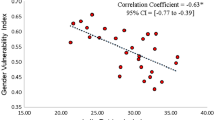Abstract
This article presents new estimates of age-specific overall and marital fertility rates for the entire United States for the period 1900‐1910. The estimation techniques are the two-census parity increment method and the own-children method. The data sources are the 1900 census public use sample and tabulations of 1910 census fertility data published with the 1940 census. Estimates are made for the total population, whites, native-born whites, foreign-born whites, and blacks. Low age-specific marital fertility at younger ages is consistent with a view of a distinctive American fertility pattern at this time.
Similar content being viewed by others
References
Anderton, D. L., and L. L. Bean. 1985. Birth spacing and fertility limitation: A behavioral analysis of a nineteenth century population. Demography 22:169–183.
Coale, A. J., M. John, and T. Richards. 1985. Calculation of age-specific fertility schedules from tabulations of parity in two censuses. Demography 22:611–623.
Coale, A. J., and N. W. Rives, Jr. 1973. A statistical reconstruction of the black population of the United States, 1880–1970: Estimates of true numbers by age and sex, birth rates, and total fertility. Population Index 39:3–36.
Coale, A. J., and T. J. Trussell. 1974. Model fertility schedules: Variations in the age structure of childbearing in human populations. Population Index 40:185–258.
— 1978. Technical note: Finding the two parameters that specify a model schedule of marital fertility. Population Index 44:203–213.
Coale, A. J., and M. Zelnik. 1963. New Estimates of Fertility and Population in the United States: A Study of Annual White Births From 1855 to I960 and of Completeness of Enumeration in the Censuses From 1880 to 1960. Princeton, N.J.: Princeton University Press.
David, P. A., and W. C. Sanderson. 1986. Rudimentary contraceptive methods and the American transition to marital fertility control, 1855–1915. Pp. 307–379 in R. Gallman and S. Engerman (eds.), Long Term Factors in American Economic Growth. Chicago: University of Chicago Press.
— 1987. The emergence of a two-child norm among American birth controllers. Population and Development Review 13:1–41.
Eblen, J. E. 1974. New estimates of the vital rates of the United States black population during the nineteenth century. Demography 11:301–319.
Farley, R. 1965. The demographic rates and social institutions of the nineteenth-century negro population: A stable population analysis. Demography 2:386–398.
Fogel, R. W. 1984. Nutrition and the Decline in Mortality Since 1700: Some Preliminary Findings, Working Paper No. 1402 (July). Cambridge, Mass.: National Bureau of Economic Research.
Glover, J. W. 1921. United States Life Tables: 1890, 1901, 1910, and 1901-10. Washington, D.C.: U.S. Government Printing Office.
Grabill, W. H., and L. J. Cho. 1965. Methodology for the measurement of current fertility from population data on young children. Demography 2:50–73.
Grove, R. D., and A. M. Hetzel. 1968. Vital Statistics Rates in the United States, 1940–1960. Washington, D.C.: U.S. Government Printing Office.
Haines, M. R. 1979. The use of model life tables to estimate mortality for the United States in the late nineteenth century. Demography 16:289–312.
Keyfitz, N., and W. Flieger. 1968. World Population: An Analysis of Vital Data. Chicago: University of Chicago Press.
Meeker, E. 1977. Freedom, economic opportunity, and fertility: Black Americans, 1860–1910. Economic Inquiry 15:397–412.
Mosk, C. 1983. Patriarchy and Fertility: Japan and Sweden, 1880–1960. New York: Academic Press.
National Center for Health Statistics, U.S. Public Health Service. 1984. Vital Statistics of the United States (Vol. 1): Natality. Washington, D.C.: U.S. Government Printing Office.
Preston, S. H., and M. R. Haines. 1984. New estimates of child mortality in the United States at the turn of the century. Journal of the American Statistical Association 79:272–281.
Ryder, N. B., and C. F. Westoff. 1971. Reproduction in the United States: 1965. Princeton, N.J.: Princeton University Press.
Sanderson, W. C. 1979. Quantitative aspects of marriage, fertility and family limitation in nineteenth century America: Another application of the Coale specification. Demography 16:339–358.
Taeuber, C, and I. B. Taeuber. 1958. The Changing Population of the United States. New York: Wiley.
Thompson, W. S., and P. K. Whelpton. 1933. Population Trends in the United States. New York: McGraw-Hill.
Tolnay, S. E. 1981. Trends in total and marital fertility for black Americans, 1886–1899. Demography 18:443–463.
Tolnay, S. E., S. N. Graham, and A. M. Guest. 1982. Own-child estimates of U.S. white fertility, 1886-99. Historical Methods 15:127–138.
Trussell, J. 1979. Natural fertility: Measurement and use in fertility models. Pp. 29–64 in H. Leridon and J. Menken (eds.), Natural Fertility. Liege: Ordina Editions.
United Nations. 1983. Indirect Techniques for Demographic Estimation (Manual 10). New York: United Nations.
—. 1943. Sixteenth Census of the United States, 1940. Population. Differential Fertility, 1940 and 1910: Fertility for States and Large Cities. Washington, D.C.: U.S. Government Printing Office.
—. 1944. Sixteenth Census of the United States, 1940. Population. Differential Fertility, 1940 and 1910: Standardized Fertility Rates and Reproduction Rates. Washington, D.C.: U.S. Government Printing Office.
—. 1945a. Sixteenth Census of the United States, 1940. Population. Differential Fertility, 1940 and 1910: Women by Number of Children Ever Born. Washington, D.C.: U.S. Government Printing Office.
—. 1945b. Sixteenth Census of the United States, 1940. Population. Differential Fertility, 1940 and 1910: Women by Number of Children Under 5 Years Old. Washington, D.C.: U.S. Government Printing Office.
—. 1975. Historical Statistics of the United States, Colonial Times to 1970. Washington, D.C.: U.S. Government Printing Office.
—. 1979. Twenty Censuses: Population and Housing Questions, 1790–1980. Washington, D.C.: U.S. Government Printing Office.
Author information
Authors and Affiliations
Rights and permissions
About this article
Cite this article
Haines, M.R. American fertility in transition: New estimates of birth rates in the United States, 1900–1910. Demography 26, 137–148 (1989). https://doi.org/10.2307/2061500
Issue Date:
DOI: https://doi.org/10.2307/2061500




